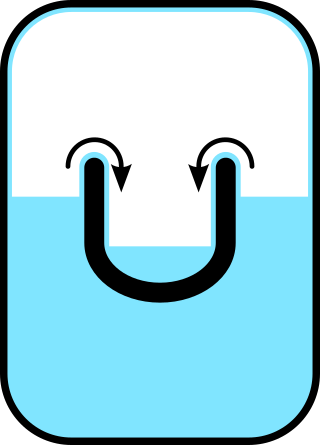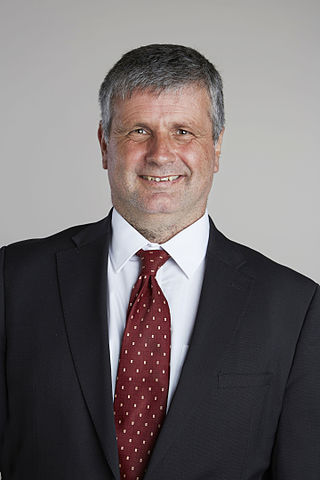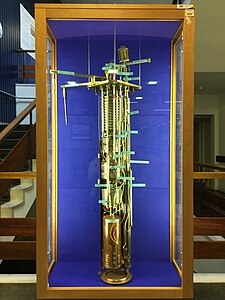- J F Allen building, hosting the School of Physics and Astronomy of the University of St Andrews
- Helium liquifier built by John F. Allen in 1952 at the University of St Andrews
Related Research Articles

In condensed matter physics, a Bose–Einstein condensate (BEC) is a state of matter that is typically formed when a gas of bosons at very low densities is cooled to temperatures very close to absolute zero. Under such conditions, a large fraction of bosons occupy the lowest quantum state, at which microscopic quantum-mechanical phenomena, particularly wavefunction interference, become apparent macroscopically. More generally, condensation refers to the appearance of macroscopic occupation of one or several states: for example, in BCS theory, a superconductor is a condensate of Cooper pairs. As such, condensation can be associated with phase transition, and the macroscopic occupation of the state is the order parameter.

Helium is a chemical element; it has symbol He and atomic number 2. It is a colorless, odorless, non-toxic, inert, monatomic gas and the first in the noble gas group in the periodic table. Its boiling point is the lowest among all the elements, and it does not have a melting point at standard pressures. It is the second-lightest and second most abundant element in the observable universe, after hydrogen. It is present at about 24% of the total elemental mass, which is more than 12 times the mass of all the heavier elements combined. Its abundance is similar to this in both the Sun and Jupiter, because of the very high nuclear binding energy of helium-4, with respect to the next three elements after helium. This helium-4 binding energy also accounts for why it is a product of both nuclear fusion and radioactive decay. The most common isotope of helium in the universe is helium-4, the vast majority of which was formed during the Big Bang. Large amounts of new helium are created by nuclear fusion of hydrogen in stars.
Superfluid helium-4 is the superfluid form of helium-4, an isotope of the element helium. A superfluid is a state of matter in which matter behaves like a fluid with zero viscosity. The substance, which resembles other liquids such as helium I, flows without friction past any surface, which allows it to continue to circulate over obstructions and through pores in containers which hold it, subject only to its own inertia.

Heike Kamerlingh Onnes was a Dutch physicist and Nobel laureate. He exploited the Hampson–Linde cycle to investigate how materials behave when cooled to nearly absolute zero and later to liquefy helium for the first time, in 1908. He also discovered superconductivity in 1911.

Lev Davidovich Landau was a Soviet physicist who made fundamental contributions to many areas of theoretical physics. He was considered as one of the last scientists who were universally well-versed and made seminal contributions to all branches of physics.

Pyotr Leonidovich Kapitsa or Peter Kapitza was a leading Soviet physicist and Nobel laureate, whose research focused on low-temperature physics.

Liquid helium is a physical state of helium at very low temperatures at standard atmospheric pressures. Liquid helium may show superfluidity.

In condensed matter physics, a supersolid is a spatially ordered material with superfluid properties. In the case of helium-4, it has been conjectured since the 1960s that it might be possible to create a supersolid. Starting from 2017, a definitive proof for the existence of this state was provided by several experiments using atomic Bose–Einstein condensates. The general conditions required for supersolidity to emerge in a certain substance are a topic of ongoing research.

A fermionic condensate is a superfluid phase formed by fermionic particles at low temperatures. It is closely related to the Bose–Einstein condensate, a superfluid phase formed by bosonic atoms under similar conditions. The earliest recognized fermionic condensate described the state of electrons in a superconductor; the physics of other examples including recent work with fermionic atoms is analogous. The first atomic fermionic condensate was created by a team led by Deborah S. Jin using potassium-40 atoms at the University of Colorado Boulder in 2003.
Don Misener (1911–1996) was a physicist. Along with Pyotr Leonidovich Kapitsa and John F. Allen, Misener discovered the superfluid phase of matter in 1937.

David Morris Lee is an American physicist who shared the 1996 Nobel Prize in Physics with Robert C. Richardson and Douglas Osheroff "for their discovery of superfluidity in helium-3." Lee is professor emeritus of physics at Cornell University and distinguished professor of physics at Texas A&M University.
Victor John Emery was a British specialist on superconductors and superfluidity. His model for the electronic structure of the copper-oxide planes is the starting point for many analyses of high-temperature superconductors and is commonly known as the Emery model.
Atomic Spectroscopy and Collisions Using Slow Antiprotons (ASACUSA), AD-3, is an experiment at the Antiproton Decelerator (AD) at CERN. The experiment was proposed in 1997, started collecting data in 2002 by using the antiprotons beams from the AD, and will continue in future under the AD and ELENA decelerator facility.

Superfluidity is the characteristic property of a fluid with zero viscosity which therefore flows without any loss of kinetic energy. When stirred, a superfluid forms vortices that continue to rotate indefinitely. Superfluidity occurs in two isotopes of helium when they are liquefied by cooling to cryogenic temperatures. It is also a property of various other exotic states of matter theorized to exist in astrophysics, high-energy physics, and theories of quantum gravity. The theory of superfluidity was developed by Soviet theoretical physicists Lev Landau and Isaak Khalatnikov.

Henry Edgar Hall FRS was a professor of low temperature physics at the University of Manchester. He was the 2004 recipient of the Guthrie Medal and Prize. Hall was awarded a Ph.D. in 1957 from Emmanuel College, Cambridge with thesis title The rotation of liquid helium II. He worked at the University of Manchester from 1958 to 1995, when he retired. He died on 4 December 2015.
William Frank Vinen was a British physicist specialising in low temperature physics.
Bose–Einstein condensation can occur in quasiparticles, particles that are effective descriptions of collective excitations in materials. Some have integer spins and can be expected to obey Bose–Einstein statistics like traditional particles. Conditions for condensation of various quasiparticles have been predicted and observed. The topic continues to be an active field of study.
Helium is the smallest and the lightest noble gas and one of the most unreactive elements, so it was commonly considered that helium compounds cannot exist at all, or at least under normal conditions. Helium's first ionization energy of 24.57 eV is the highest of any element. Helium has a complete shell of electrons, and in this form the atom does not readily accept any extra electrons nor join with anything to make covalent compounds. The electron affinity is 0.080 eV, which is very close to zero. The helium atom is small with the radius of the outer electron shell at 0.29 Å. Helium is a very hard atom with a Pearson hardness of 12.3 eV. It has the lowest polarizability of any kind of atom, however, very weak van der Waals forces exist between helium and other atoms. This force may exceed repulsive forces, so at extremely low temperatures helium may form van der Waals molecules. Helium has the lowest boiling point of any known substance.

Andrew Peter Mackenzie is a director of Physics of Quantum Materials at the Max Planck Institute for Chemical Physics of Solids in Dresden, Germany and Professor of Condensed Matter Physics at the University of St Andrews, Scotland. He became a co-editor of the Annual Review of Condensed Matter Physics as of 2020.
GrigoryEfimovich Volovik is a Russian theoretical physicist, who specializes in condensed matter physics. He is known for the Volovik effect.
References
- ↑ Armitage, Jonathan G. M.; Longair, Malcolm S. (2023). "John Frank Allen. 6 May 1908—22 April 2001". Biographical Memoirs of Fellows of the Royal Society. 75: 7–27. doi: 10.1098/rsbm.2023.0021 .
- 1 2 3 Donnelly, Russell J. (July 2002). "Obituary: John Frank Allen". Physics Today. 55 (7): 76–77. Bibcode:2002PhT....55g..76D. doi: 10.1063/1.1506759 .
- ↑ Allen, J.F. (1966). "Obituary: Frank Allen". Nature. 209: 133. doi: 10.1038/209133b0 .
- 1 2 3 4 "John Allen Eminent physicist who was the discoverer of superfluid helium". Herald Scotland. 28 April 2001.
- ↑ Donnelly, Russell J. (July 1995). "The Discovery of Superfluidity". Physics Today. 48 (7): 30–36. Bibcode:1995PhT....48g..30D. CiteSeerX 10.1.1.525.6885 . doi:10.1063/1.881467.
- ↑ Pearce Wright (4 May 2001). "Obituary: John Allen". The Guardian.
- ↑ Allen, J.F. and Misener, D. (January 1938). "Flow of Liquid Helium II". Nature. 141 (3558): 75. Bibcode:1938Natur.141...75A. doi: 10.1038/141075a0 . S2CID 4094549.
{{cite journal}}: CS1 maint: multiple names: authors list (link) - ↑ Kapitza, P. (January 1938). "Viscosity of Liquid Helium below the λ-Point". Nature. 141 (3558): 74. Bibcode:1938Natur.141...74K. doi: 10.1038/141074a0 . S2CID 3997900.
- ↑ Balibar, S. (2007). "The Discovery of Superfluidity". Journal of Low Temperature Physics. 146 (5–6): 441–470. arXiv: physics/0611119 . Bibcode:2007JLTP..146..441B. doi:10.1007/s10909-006-9276-7. S2CID 119067574.
- 1 2 3 4 "Directory of Fellows of the Royal Society" . Retrieved 21 August 2019.[ permanent dead link ]
- 1 2 3 Griffin, Allan (2001). "Obituary: John Frank (Jack) Allen (1908–2001)". Nature. 411 (6836): 436. Bibcode:2001Natur.411..436G. doi: 10.1038/35078192 . S2CID 36121636.
- ↑ Waterston, C. D; Shearer, A. Macmillan (2006). Former fellows of The Royal Society of Edinburgh, 1783–2002: biographical index (PDF). The Royal Society of Edinburgh. p. 18. CiteSeerX 10.1.1.397.5305 . ISBN 978-0-902198-84-5. OCLC 83595094.
- ↑ "Heriot-Watt University Edinburgh: Honorary Graduates" (PDF). Retrieved 21 August 2019.
- ↑ Griffin, Allan (May 2001). "John Frank (Jack) Allen (1908–2001)". Nature. 411 (6836): 436. doi: 10.1038/35078192 . S2CID 36121636.
- ↑ "Feedback". New Scientist: 32. 13 December 1984. ISSN 0028-6664 . Retrieved 5 May 2023.
Professor Allen says he has altered his apparatus (which was too small to produce separate drips) so that it duplicates more precisely the experiment at Queensland

